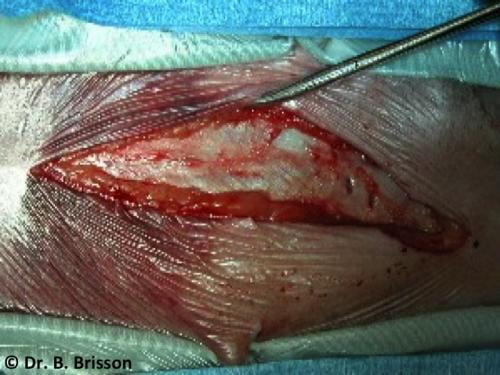Chapter 1: Table of Contents
Contents
Terminology Overview

Most veterinary surgery terms describing procedures are composed of a prefix and a suffix. The prefix is the first part of the word, which usually refers to the organ or structure that is involved. The suffix is the last part of the word and often denotes the type of procedure. For example, a thoracotomy (a surgical procedure involving an incision in the thorax) can be divided into the prefix: thoraco- and the suffix -otomy. Thoraco- refers to the thorax and -otomy denotes a surgical procedure in which a structure is cut. Further description can be added to better describe the location or procedure being performed. For example, a sternal thoracotomy (also known as a ‘sternotomy’) involves an incision through the sternum to enter the thoracic cavity whereas an intercostal thoracotomy is an incision in the thorax between two ribs.
A few suffixes are commonly combined to prefixes to describe surgical procedures performed in veterinary medicine. Learning these suffixes will facilitate your understanding and prevent you from being overwhelmed by the terminology. It will also ensure that you use correct terminology when describing procedures to your peers.
– OTOMY:

A surgical procedure in which a structure is cut.
Gastrotomy: A gastrotomy is a procedure in which an incision
(-otomy) is made into the stomach (gastro-). This is typically performed to obtain a gastric biopsy or to remove a foreign body. The incision is then sutured closed.
Cystotomy: A cystotomy is a procedure in which an incision (-otomy) is made into the urinary bladder (cysto-). This is typically performed to remove urinary calculi (stones) or obtain bladder wall biopsies. The incision is then sutured closed.
Celiotomy: A celiotomy is a procedure in which an incision (-otomy) is made through the abdominal wall (celio-), usually through the midline. Laparotomy is used interchangeably but in the strict sense actually describes an abdominal approach through a flank incision.
-ECTOMY:

A surgical procedure in which a portion of tissue is removed / resected.
Ovariohysterectomy: An ovariohysterectomy is a procedure in which the ovaries (ovario-) and uterus (-hyster-) are surgically removed (-ectomy). This prevents cycling, pregnancy and the development of uterine infections (pyometra). It is commonly known as a ‘spay’ procedure.
Femoral Head and Neck Ostectomy: A femoral head and neck ostectomy is a procedure in which the head and neck of the femur are surgically removed (-ectomy). This is frequently performed to palliate dogs with hip dysplasia. It is commonly known as an FHO (femoral head and neck ostectomy).
-STOMY:

A surgical procedure in which a new opening is created on a temporary or permanent basis.
Tracheostomy: A tracheostomy is a procedure in which a new permanent opening ostomy) is created through the skin of the neck into the trachea (tracheo-).
Gastrostomy: A tube gastrostomy is a procedure in which a tube is placed through the body wall and into the stomach in order to create a new, temporary opening in the stomach. This tube is typically used to feed a patient that is anorexic or that cannot tolerate oral feeding.
Urethrostomy: A urethrostomy is a procedure in which a new permanent opening (-ostomy) is created in the urethra (urethro-) that communicates with the skin. In this case, a scrotal urethrostomy was performed at the level of the scrotal urethra.
-PLASTY

A surgical procedure in which an alteration is performed to an organ or body structure, it is usually permanent. Think of plastic surgery. The term ”-plasty” is also used as a suffix when an artificial prosthesis is implanted to replace an original body part.
Hip Arthroplasty: A total hip arthroplasty is a surgical procedure that involves replacing the hip joint (arthro-) with a prosthetic implant (-plasty) (also know as ‘total hip replacement’).
Cheiloplasty: A cheiloplasty is a surgical procedure that involves the repair or surgical modification (-plasty) of the lip (cheilo-).
Vulvoplasty: A vulvoplasty is a surgical procedure that surgically changes the shape (-plasty) of the vulva (vulvo-). This procedure is often performed to correct an underdeveloped vulva or a vulva that is recessed due to excessive perineal fat in an overweight patient.
-PEXY:

A surgical procedure in which a permanent or temporary adhesion is created between two structures (usually using suture, sometimes using atube).
Gastropexy: A gastropexy is a procedure in which the stomach (gastro-) is affixed (-pexy) to the abdominal wall. This procedure is typically performed to prevent the recurrence of gastric dilatation-volvulus (GDV) in dogs.
-OSCOPY:

A surgical procedure involving the use of an optical instrument (an endoscope, an otoscope, an arthroscope, etc.) to visualize organs or structures.
Laparoscopy: Laparoscopy is a procedure in which an optical instrument (laparoscope) is used to visualize the abdominal organs (laparo-) in a minimally invasive manner.
-RRHAPHY:

A surgical procedure in which a structure is sutured or repaired.
Herniorraphy: A herniorrhaphy describes the surgical repair (-rrhaphy) of a hernia (hernio-). Traumatic diaphragmatic hernia is common secondary to being hit by a car.
Cystorrhaphy: A cystorrhaphy is the surgical repair (-rrhaphy) of a tear in the bladder wall (cysto-).
-CENTESIS:

A surgical procedure in which a cavity or structure is punctured in order to aspirate fluid, air or tissue. Paracentesis is sometimes used synonymously.
Abdominoscentesis: Abdominocentesis or abdominal paracentesis involves puncture (-centesis) of the abdominal cavity (abdomino-) using a small trocar or needle and is typically performed to aspirate free abdominal fluid (also known as effusion).
Throacocentesis: Thoracocentesis involves puncture (-centesis) of the thoracic cavity (thoraco-) in order to aspirate free fluid or air. This procedure is frequently performed to treat pneumothorax (pneumo = air), a condition in which free air accumulates within the thoracic cavity and compresses the lungs causing respiratory difficulty.


